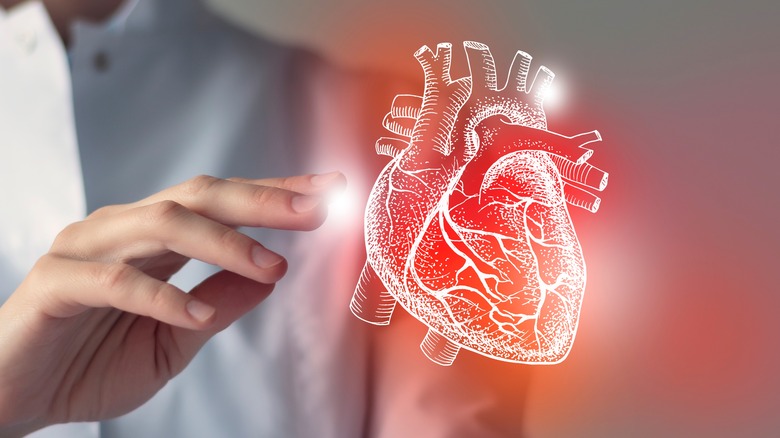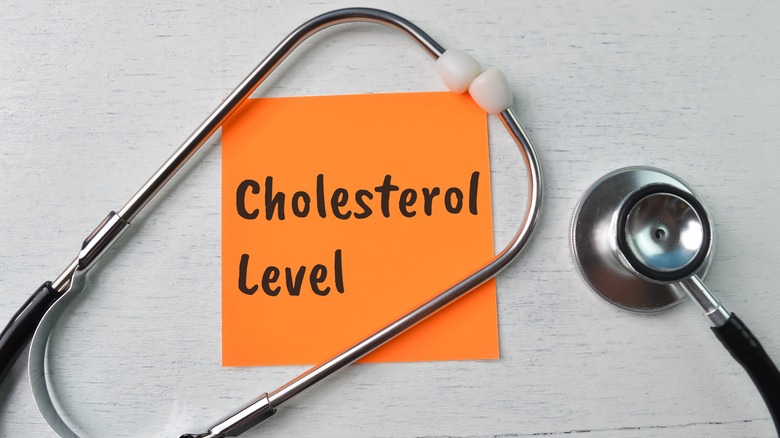Your Cholesterol Levels Mean More Than You Think
According to Johns Hopkins Medicine, approximately 71 million people in the United States have high cholesterol levels. However, many people are unaware of exactly what cholesterol is and the effects of high cholesterol levels on the body. Cholesterol is one of the so-called dietary fats and a vital body substance. Healthline states that it serves as a building block in the formation of sex hormones, bile acid, and human tissues. It also plays a vital role in forming vitamin D and substances that aid digestion, per MedlinePlus.
WebMD notes that cholesterol isn't water-soluble due to its fat-like structure. Therefore, it can't swim through the watery blood. The body assists with the transportation by coating cholesterol with water-soluble proteins. This combination of cholesterol, protein and other fats is called lipoprotein, per MedlinePlus. WebMD states that the two main lipoproteins are high-density lipoprotein (HDL) and low-density lipoprotein (LDL).
LDL is usually called the "bad" cholesterol, as it sticks to the walls of the blood vessels, according to WebMD. Excessively high LDL cholesterol levels indicate an increased risk of heart attacks and strokes, per the Cleveland Clinic. On the other hand, HDL absorbs the cholesterol deposited in the blood vessels' walls and transports it back to the liver (via WebMD). Normal-to-high HDL levels offer a protective effect against cardiovascular diseases. Colloquially, HDL is therefore referred to as the "good" cholesterol, as noted by WebMD.
How are cholesterol levels determined?
The best way to understand your cholesterol levels is through a complete cholesterol test, also called a lipid panel or lipid profile test, per the Mayo Clinic. A lab test can determine the values of total cholesterol, HDL cholesterol, and LDL cholesterol. Cholesterol values are given in units of milligrams per deciliter (mg/dl) or millimoles per liter (mmol/l). According to the Mayo Clinic, the lab slip may also show the relative ratio between HDL and LDL cholesterol, known as the LDL/HDL ratio.
MedicalNewsToday states that total cholesterol levels should be less than 200 mg/dl for healthy adults, which is 5.2 mmol/l. A value of over 40 mg/dl applies to HDL (the "good" cholesterol). If the value is lower, the risk of vascular calcification increases, per MedicalNewsToday. The source also states that LDL (the "bad" cholesterol) should be below 100 mg/dl. Elevated cholesterol levels usually don't cause any symptoms, hence the need for a complete cholesterol test (via Mayo Clinic). The Centers for Disease Control and Prevention says people over 20 years old should have a checkup every five years.
Causes and treatment options for high cholesterol
According to Healthline, many factors — including genetics — contribute to high cholesterol levels. If there are elevated values in the family (familial hypercholesterolemia), even children can have high cholesterol levels. WebMD adds that lifestyle also has an influence on blood lipid levels — for example, excessive stress, poor diet, and a limited amount of physical activity. In addition, certain medications and medical conditions can increase the values. This includes type 2 diabetes and an underactive thyroid, per WebMD.
MedlinePlus states making lifestyle changes is an important step when treating high cholesterol. This includes regular exercise, managing excess weight, and eating a balanced diet. MedlinePlus also notes that medication like statins may be necessary if lifestyle changes don't work. According to the Cleveland Clinic, they're commonly prescribed cholesterol-lowering drugs. When taken, they can potentially reduce your LDL levels by more than 50% and improve your cholesterol levels.



